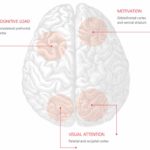July 27, 2015: Much of advertising is designed to create memories that are reactivated at the point of purchase. These memories — created by exposure to billboards, television, direct mail, magazines, or via digital media — are intended to be reactivated in the mind of the recipient at the point of purchase, for example, when passing the advertised product on a supermarket aisle shelf. Working with researchers at Temple University, the U.S. Post Office recently published a study evaluating the degree to which different kinds of advertising — specifically digital or physical ads — are effective at creating long-term memories.
The USPS study follows up on an earlier, similar study conducted by the UK’s Royal Mail which found that physical mail generated “stronger responses in terms of engagement, emotional intensity, and memory when compared to email and television.”
Study Results
The study used a range of “neuromarketing” devices and methods, including eye-trackers, skin sensors, heart rate monitors, MRI devices, plus traditional self-reporting, to monitor and evaluate subjects’ responses to digital and physical advertising in two distinct phases: first, at the moment when a subject experiences the ad unit and later, when the subject was asked to recall the contents of ad units and express (or fail to express) a desire for the advertised product and a willingness to buy it.
The study noted that subjects processed ads in physical form differently from digitally-delivered ads. “Participants tended to spend more time when interacting with physical advertisements and this also translated to a higher number of fixations (pausings of the eye) recorded.”
Furthermore, “when viewing physical ads, participants had stronger emotional response and remembered them better. Physical ads, while slower to get one’s attention at first exposure, leave a longer lasting impact for easy recall when making a purchase decision. Most importantly, physical ads triggered activity in the area of the brain (ventral striatum) that is responsible for value and desirability for featured products, which can signal a greater intent to purchase.”
Marketing Implications
While the study’s findings strongly suggest that physical advertising is better in terms of generating long-term memories capable of being reactivated at the point of purchase, it would be a mistake to conclude that digital advertising doesn’t have a powerful role to play in the buying process. Digital ads are more efficient in terms of delivering large amounts of information in a short time period, and subjects exposed to them demonstrate higher levels of instantaneous attention.
“The digital format captures attention quicker. However, for longer lasting impact and easy recollection, a physical mail piece is the superior option that could lead to a purchase. This suggests a complementary effect between the two formats that could provide a powerful way for marketers to optimize their media mix, especially as companies look to reach digitally connected customers.”
You can read the complete USPS study at the following URL:
https://www.uspsoig.gov/sites/default/files/document-library-files/2015/rarc-wp-15-012.pdf











![By Photograph: Frank C. Müller, Baden-Baden (Own work) [CC BY-SA 2.5 (http://creativecommons.org/licenses/by-sa/2.5)], via Wikimedia Commons](https://www.diditdm.com/wp-content/uploads/2015/08/opening-an-envelope-150x150.jpg)
![By User:Introvert (Own work) [CC BY-SA 2.5 (http://creativecommons.org/licenses/by-sa/2.5)], via Wikimedia Commons](https://www.diditdm.com/wp-content/uploads/2015/10/1024px-Sparkling-snow.sierra-150x150.jpg)